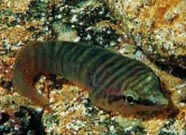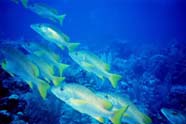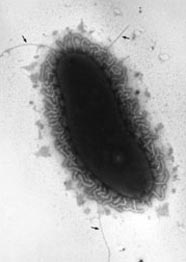| |
Glossary of Coral Reef Terminology - V
v. et. - see also (vide etiam) |
vaccine - a preparation that contains an antigen, consisting of dead or weakened whole or parts of disease-causing organisms, that is used to confer immunity against the disease that the organisms cause. Vaccine preparations can be natural, synthetic or derived by recombinant DNA technology |
vacuolated - possessing vacuoles |

A water vacuole in an ameba. (Graphic: Wappingers Schools)
|
vacuole - a membrane-bounded vesicle in eukaryotic cells that has a secretory, endocytotic, phagocytotic or storage function |
vacuolization - the formation or multiplication of vacuoles |
vagile - freely motile; wandering; mobile |
vagility - the capacity of an organism or population to change its location or distribution with time; ability to migrate |
vaginate - enclosed by a sheath |
vagrant - a species that has strayed beyond its natural range but has not established reproducing populations |
valence - the chemical combining capacity of an element or ion; the number of electrons that are used by an atom to form a compound. A valence electron is in the outer or next outer shell of an atom |
valid name - in taxonomy, the correct name for a given taxon, which may have several available names, one of which (usually the oldest) is chosen as the valid name. The valid name is always an available name, but an available name is not always a valid name |
validated name - in taxonomy, a formerly invalid or unavailable name that has been made valid or available by the International Code of Zoological Nomenclature, e.g. by annulment or suppression of senior homonyms or synonyms |

A giant tridacna clam with its two valves open.
|
valve - the shell or shells of certain organisms, such as clams, oysters, and snails |
variance - the population variance of a random variable is a non-negative number which gives an idea of how widely spread the values of the random variable are likely to be; the larger the variance, the more scattered the observations on average. It is a measure of the 'spread' of a distribution about its average value |
variant - any individual or group that deviates form the typical anatomy or behavior; in genetics, an organism that is genetically different from the wild type organism |
variegated color pattern - an irregular pattern of small, dark and light markings, with many of the dark marks connected |
vas deferens - a duct that carries spermatozoa away from a testis |
vascular plant - any plant containing a system of vessels which transport water and nutrients between different parts of the plant (e.g., from the roots to the leaves) |
vasculature - the network of blood vessels in an organ or body part; tissue consisting of cells joined to form tubes for transporting fluids through a body |
vaterite - a mineral consisting of CaCO3 , and thus a polymorph of calcite and aragonite, with very limited occurrence in nature. Vaterite is less stable than either calcite or aragonite. It has a higher solubility than either of the other polymorphs of CaCO 3. Therefore, once vaterite is exposed to water, it converts to calcite (at low temperature) or aragonite (at high temperature: ~60°C). Vaterite occurs naturally in mineral springs, organic tissues, gallstones, and urinary calculi |
vector - an abstraction of the real world where positional data is represented in the form of coordinates. In vector data, the basic units of spatial information are points, lines and polygons. Each of these units is composed simply as a series of one or more coordinate points. For example, a line is a collection of related points, and a polygon is a collection of related lines. Vector images are defined mathematically as a series of points joined by lines. Vector-based drawings are resolution independent. This means that they appear at the maximum resolution of the output device, such as a printer or monitor. Each object is self-contained, with properties such as color, shape, outline, size, and position on the screen |
vector - an organism which carries or transmits a pathogen; a vehicle that transfers genetic material into a host cell or organism. Typically, vectors are of two types: viral- or DNA-based. DNA vectors are automously replicating, circular macromolecules that can be easily manipulated to carry genetic information and are transferred into cells by standard laboratory techniques. These vectors include plasmids, cosmids, and yeast artificial chromosomes (YACs). Recombinant viruses that have been bioengineered to be harmless can also carry new genetic information for transfer into cells, or into an entire host organism (an example of gene therapy) |
vegetal coloration - a resemblance to vegetation which allows organisms to conceal themselves from predators or prey |
vegetal hemisphere - the half of an oocyte or egg with more yolk, or the corresponding half of an early embryo with the slower dividing yolk-laden cells |
vegetal pole - the portion of an oocyte or egg that is opposite the animal pole and contains most of the yolk granules. See "animal pole" |
vegetative reproduction - a reproductive process that is asexual and so does not involve a recombination of genetic material. It involves unspecialized plant parts which may become reproductive structures (such as roots, stems, or leaves); also called "vegetative propagation" |
velarium - a structure that resembles a hydrozoan velum In scyphozoan medusae, but has a different embryonic origin |
veliger - a molluskan larva in which the foot, mantle and shell first make their appearance |
velocity - the rate of change of position over time, calculated by dividing distance by time |
velum - a circular shelf of tissue attached to the underside of the umbrella in a hydrozoan mesusa. It functions in locomotion |
veneer reef - a reef with very little calcium carbonate accretion. A non-reef coral community |

A venomous cone shell. When close to its prey, usually another gastropod mollusk, it expands its long proboscis exploring for soft parts. A radular dart, bearing venom, is injected into the prey; death quickly results. (Photo: Dr. James P. McVey, NOAA Sea Grant Program)
|
venomous - pertaining to an organism that has a venom, usually secreted by a gland, that is injected through hollow spines or teeth |
vent - the posterior opening of the intestine, gonads, and kidney ducts. The vent is located just anterior to the anal fin in fishes |
ventral - pertaining to, or situated near, the belly, or underside, of an animal |

A clingfish's ventral disc allows it to hold onto rocks in strong currents or when waves crash over tide pools.
|
ventral disk - a "sucking disc " formed by the uniting of the pelvic fins in some fishes; for example, clingfishes |
ventral fin - a synonym for pelvic fin |
Verhulst's Law - although individuals may benefit from the presence of conspecifics, population growth cannot go on forever without negative consequences. Eventually, an upper boundary is reached beyond which population density cannot increase |
vermetid reef - a reef composed of vermetid gastropods (a family of marine snails) built on some substrate such as coralline algae or bivalve shells. These filter-feeding shelled snails, called worm-shells, are gregarious colonial animals which develop massive structures. A vermetid reef may be seen in southwestern Florida, south of Fort Meyers in the Ten Thousand Islands area |

A vermetid tube among coral branches. The snail's operculum covering the shell's opening is visible.(Photo: Ron Shimek)
|
vermetid tube - the "tube" of the worm-shell snail |
vermiculation - a worm-like marking |
vermilion - bright red color |
vermivore - an animal which feeds upon worms and worm-like animals |
vernacular name - the colloquial or common name of a taxon, i.e., in any language or form other than that of biological nomenclature. Vernacular names have no status in nomenclature |
verruca - a wart-like projection; a small cylindrical projection arising from the corallum that contain calices |
verrucose - having a warty appearance |
versus - against; in contrast to |
vertebra - one of the bony segments of the vertebral column of vertebrate animals; in brittlestars (Echinodermata-Ophiuroidea), a vertebra is one of the many articulated ossicles that join together along the length of the arms. They occupy most of the interior of each arm, and have sockets by which they connect to each other |

Vertebrate animals of the fish class Osteichthyes. (Photo: Dr. Anthony Picciolo)
|
vertebrate - an animal that possesses a vertebral column (back bone), such as fishes, amphibians, reptiles, birds and mammals |
vertical classification - classification which stresses common descent and tends to unite ancestral and descendant groups of a phyletic line in a single higher taxon, separating them from contemporaneous taxa having reached a similar grade of evolutionary change |
vertical fin - the unpaired dorsal, caudal and anal fins. Vertical fins are also called median fins |
vertical migration - the diel behavior of zooplankton and some nekton to descend from surface waters during the daytime and ascend to the surface during nighttime hours |
vertical zonation - horizontal banding of communities of organisms in response to a vertical environment gradient |
vesiculate - thin and bladder-like |
vestibular system - a sensory system of fluid-filled canals, located in the inner ear of vertebrates, that assists in balance, coordination and orientation.The vestibular system comprises two components: the semicircular canal system, which indicate rotational movements and the otoliths which indicate linear translations. The inner ear of the oyster toadfish (Opsanus tau) is so similar to the human inner ear, that oyster toadfish were aboard a space shuttle flight to study the effects of microgravity on balance and equilibrium |
vestigial structure - an incompletely or ineffectively developed structure which is greatly reduced from the original ancestral form and is no longer functional |
Vestimentifera - a former phylum of benthic marine tube worms, now considered by many to belong to the family Siboglinidae of the phylum Polychaeta. Vestimentiferans live close to hydrothermal vents on mid-ocean ridges and around cold sulphidic or hydrocarbon seeps on continental slopes. They feed primarily on symbiotic (mutualistic) hydrogen sulfide- or methane-oxidizing bacteria living in an internal organ, the trophosome |
vestimentum - a short region immediately behind the head of a vestimentiferan tube worm.The front part of the vestimentum forms a collar. This region may secrete the tube |
viable - having the capacity to live, grow, germinate or develop; capable of life or normal growth and development |
vibraculum - a bryozoan heterozooid that possesses long setae, or bristles, and may function in cleaning the colony |

Vibrio vulnificus pili, a bacterium normally found in temperate estuarine waters, and as a colonizer of molluscan shellfish, such as oysters. (Photo: NOAA Northwest Fisheries Science Center)
|
Vibrio - a genus of motile, gram-negative, rod-shaped bacteria characterized by short, slightly sinuous filaments and an undulatory motion. Some species in this genus cause cholera in humans and other diseases in other animals, including corals |
vibrotaxis - an organism's response to mechanical vibrations |
vicariant event - an unexpected or abnormal event |
vicariant speciation - speciation when a single, widespread population is divided by (1) the emergence of an extrinsic barrier, (2) extinction of intervening populations, or (3) migration of some individuals into a separate region |
vice - in place of; rather than |
video transect - a nondestructive, repeatable procedure for assessing and monitoring diurnally active fishes and other macroscopic marine organisms. Videotaping along a linear transect reduces the variance in error inherent with visual observations made by a diver or snorkeler, and allows virtually unlimited time for study of the images by many individuals |
villiform - taking the form of villi (finger-like projections); in fishes, pertains to teeth which are slender and crowded closely together in bands |
villus - a small, fingerlike or hairlike projection of the small intestinal wall that contains connective tissue, blood vessels, and a lymphatic vessel, and which functions in the absorption of nutrients |
violaceous - violet color |
violet - bluish purple color |
viral DNA - DNA (deoxyribonucleic acid) that makes up the genetic material of viruses |
virion - a complete infectious viral particle, existing outside of a host cell, with nucleic acid and capsid, and in some types, an outer lipid envelope |
viroid - an infectious particle similar to a virus, but smaller. It consists only of a strand of nucleic acid without the protein coat (capsid) characteristic of a virus |
virology - the study of viruses |
virtual library - virtual libraries provide online access to specialized collections of information resources. Normally they include bibliographic citations with links to full text documents and other online resources such as video or photos. Virtual Libraries can also serve as gateways to information and resources on science, management, and policy for researchers, scientists, resource managers, policymakers, stakeholders, and the general public. Restoration, Marine Protected Areas, and Coral Reefs are examples of three NOAA virtual libraries in such areas |
virulence - the ability to infect or cause disease |
virulence - the disease-producing ability of a microorganism |
virus - a sub-microscopic, obligate intracellular parasite that replicates itself only within cells of living hosts; many are pathogenic; the structure of a virus is basically a strand of nucleic acid (DNA or RNA) wrapped in a thin protein shell. A virus is not a cell, and is "lifelike" only when replicating itself at the expense of the host cell |
viscera - the internal organs, collectively, of an coelomate organism, especially those located within the abdominal cavity, but also to the organs within the thoracic and mediastinal cavities |
visceral hump - the main body of a mollusk, which contains most of the organs, including a complete digestive and excretory tract as well as the reproductive organs. The visceral hump also includes the mantle, which consists of two external flaps of tissue that secretes the material that forms the shell on some species, and it protects the mantle cavity. The mantle cavity contains the gills, which excrete waste and circulate oxygen. Most mollusks have a shell, which sits on the visceral hump and a protects the main body from predators |
viscid egg - an adhesive egg that is deposited on sand, gravel, plants, etc. to which it sticks by means of the egg's sticky surface |
viscosity - a measure of resistance to flow in a liquid |
visible radiation - energy at wavelengths from 400 - 700 nm that is detectable by the human eye |
visible spectrum - that part of the electromagnetic spectrum to which the human eye is sensitive, between about 0.4 and 0.7 micrometers |
visible wavelengths - wavelengths approximately 400 to 700 nm |
visualization tool - a method of visually displaying data, such as a visualization theater, computer display, and map and chart |
vitamin - a chemical substance, required in trace concentrations, which acts as a cofactor with an enzyme in catalyzing a biochemical reaction |
vitamin B complex - a large group of water soluble vitamins that function as co-enzymes |
Vitareef program - a program that was established in order to provide a standardized method of characterizing the conditions of reef corals. It can and has been used by both researchers and non-scientists to document observations of reefs at specific points in time, which can be followed up in subsequent observations to assess changes in the state of individual coral colonies, selected coral species, or a reef as a whole |
vitellaria larva - a ciliated larva of echinoderms, such as sea lillies (Crinoidea), some sea cucumbers (Holothuroidea), and brittle stars (Ophiuroidea) |
viviparity - a form of reproduction where the offspring are nourished in the reproductive tract of the female (other than by a yolk sac) and then expelled from the mother as free-swimming young. Mangrove reproduction by means of propagules is also a form of viviparity in plants |
vocalization - a sound intentionally produced by an animal |
volant - flying or capable of flying |
volcanism - the set of geological processes that result in the expulsion of lava, pyroclastics, and gases at the Earth's surface |
voucher specimen - any specimen that serves as a basis of study and is retained as a reference. It should be in a publicly accessible scientific reference collection. A type specimen is a particular voucher specimen which serves as a basis for the taxonomic description of a species |
vulnerable species - a species that is particularly at risk because of low or declining numbers, a small range, or for some other reason, but is not threatened or endangered |
|
|
|
|

